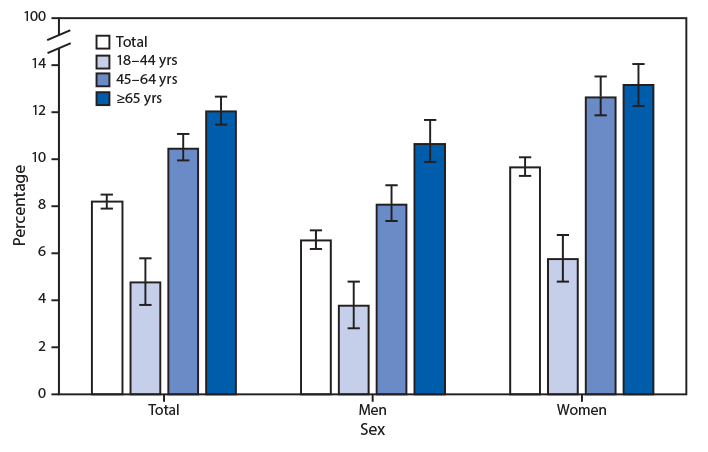QuickStats: Percentage* of Adults Aged ≥18 Years Who Took Medication To Help Fall or Stay Asleep Four or More Times in the Past Week,† by Sex and Age Group — National Health Interview Survey, United States, 2017–2018§
Weekly / December 13, 2019 / 68(49);1150
Altmetric:

* With 95% confidence intervals indicated by error bars.
† Based on a response of four or more to the survey question “In the past week, how many times did you take medication to help you fall asleep or stay asleep?”
§ Estimates are based on household interviews of a sample of the civilian, noninstitutionalized U.S. population and are derived from the National Health Interview Survey, Sample Adult component.
During 2017–2018, 8.2% of adults aged ≥18 years took medication to help fall or stay asleep four or more times in the past week (6.6% for men and 9.7% for women). Among men, the percentage who took medication for sleep four or more times in the past week increased with age from 3.8% among those aged 18–44 years to 10.7% among those aged ≥65 years. Among women, the percentage increased from 5.8% for those aged 18–44 years to 12.7% among those aged 45–64 years and 13.2% among those aged ≥65 years. Across all age groups, the percentage was higher among women than men.
Source: National Center for Health Statistics, National Health Interview Survey, 2017 and 2018. https://www.cdc.gov/nchs/nhis.htm.
Reported by: Cynthia Reuben, MA, car4@cdc.gov, 301-458-4458.
Suggested citation for this article: QuickStats: Percentage of Adults Aged ≥18 Years Who Took Medication To Help Fall or Stay Asleep Four or More Times in the Past Week, by Sex and Age Group — National Health Interview Survey, United States, 2017–2018. MMWR Morb Mortal Wkly Rep 2019;68:1150. DOI: http://dx.doi.org/10.15585/mmwr.mm6849a5.
MMWR and Morbidity and Mortality Weekly Report are service marks of the U.S. Department of Health and Human Services.
Use of trade names and commercial sources is for identification only and does not imply endorsement by the U.S. Department of
Health and Human Services.
References to non-CDC sites on the Internet are
provided as a service to MMWR readers and do not constitute or imply
endorsement of these organizations or their programs by CDC or the U.S.
Department of Health and Human Services. CDC is not responsible for the content
of pages found at these sites. URL addresses listed in MMWR were current as of
the date of publication.
All HTML versions of MMWR articles are generated from final proofs through an automated process. This conversion might result in character translation or format errors in the HTML version. Users are referred to the electronic PDF version (https://www.cdc.gov/mmwr) and/or the original MMWR paper copy for printable versions of official text, figures, and tables.
Questions or messages regarding errors in formatting should be addressed to mmwrq@cdc.gov.